 March 2003
March 2003
The Daley News
Welcome back to another Daleys Day. I hope you all have had a drop or two of rain over the last month. In just a snapshot of the enquiries coming into the nursery over the last few weeks, I can assure you that there are a lot of cheerful gardeners getting their 'wellies' on.
Well I must make an apology for all of you who so diligently peruse this newsletter each month. I promised you last month that I would cover nitrogen-fixing plants in your orchard and frog attracting plants. Well I have a confession to make. On receipt of an email that at first made me chuckle and then sent me on an investigative journey I got NUTTY. I hope you will excuse the delay and look out for our April Issue, which will cover all the above-mentioned topics and more.
Our Special Feature for the Month
COMPLETELY NUTS
 Cashews, Pine Nuts. Malabar Chestnuts, Pecans, Almonds, Hazelnuts, Indian Almonds, Macadamias, Bunya Nuts and Walnuts, Chestnuts...too many to choose from. All of the above can be found in the nursery throughout the year. I would like to introduce you to a few of the less common ones.
Cashews, Pine Nuts. Malabar Chestnuts, Pecans, Almonds, Hazelnuts, Indian Almonds, Macadamias, Bunya Nuts and Walnuts, Chestnuts...too many to choose from. All of the above can be found in the nursery throughout the year. I would like to introduce you to a few of the less common ones.
This segment was inspired by an email sent in by a fruit enthusiast from North Queensland on their comical and rather mucky adventure with preparing their Cashews. Enjoy the read and many thanks to Tony and Gordon for sharing their experience.
Dear Emma,
Thank you for the information you sent us regarding the harvesting and preparation of cashews. We combined both your experience in the Solomon Islands and that which you included from the Internet. Unfortunately we did not have any success and perhaps the advice we can pass on is 'What not to do with cashews'.
We assessed the alternative heat treatments for the removal of the nuts, very conscious of the toxic resin warnings. We decided to heat out entire crop (26 nuts) in a very slightly greased wok over the gas stove in the kitchen. That was our first big mistake. The smoke emitted ensured that every window and door in the house was open, providing a through draught, and the extractor fan directly above the wok was also on high. It was impossible to escape the smoke and the fumes and it was only a matter of minutes before we were both gasping for air and suffering from a dry and burning throat. It can only be assumed that the fumes are also toxic and that this exercise should not be undertaken in a closed or confined area.
The nuts began to bubble at the centre of the curve of the kidney shape and we thought we were making some progress. The outside of the shells started to blacken and every now and again one nut would go off with a spit and a puff. They then started to exude a black oil which was sticking to the wooden spoon with which we were constantly moving the nuts. We put one nut on a white plate and took it outside for an individual and closer inspection. It had the appearance of a burnt cashew shell in rich chocolate sauce.
We opted for the assistance of 'steaming' mentioned in the internet article and poured a little water into the wok. While it may not have assisted the splitting process of the nut, it certainly cut down considerably the smoke and fumes. And that was a huge bonus. We found we could now watch and breathe at the same time. Our 26 nuts continued to 'steam' but the liquid soon resembled disgusting dark muddy, and we believed, toxic water. "Let's take the wok outside and hose the nuts and start off again with clear 'steaming' water." A second attempt was no more successful; the sticky dark brown, we presumed toxic resin, coated all the nuts, the wok and the wooden spoon. We tipped the nuts out onto newspaper to allow them to dry and to reassess the progress.
After half an hour there was a unanimous decision that they should go in the bin and that $16 plus was a cheap price to pay for a kilo of cashews at the supermarket. We are going to spend more than that on throat lozenges and a new wok.
We will stick to processing our delicious pickled lychees.
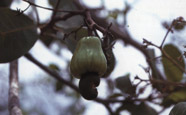 Cashew - Anacardium occidentale
Cashew - Anacardium occidentale
Both the cashew apple and nut (seed) of the cashew tree are edible. The fleshy 'apple' is really the swollen stalk (peduncle) and base to which the seed is attached. Technically, the actual nut is the thick-shelled seed. The outer shell (coat) of the seed contains the poison oak allergen urushiol, and may cause dermatitis in hypersensitive people. Cashew nuts are not the easiest of nuts to prepare for a snack. Their shell is full of anacardic acid. You have to remove the shell without destroying the nut and without getting the acid in your eyes. According to Tropical Food Garden by Leonie Norrington.
The instructions for this process are as follows:
Raise your oil to boiling at about 210 degrees Celsius. Using a grill to keep them under, and cook for 105-120 seconds. They will jump and hiss and spurt acid at you and the oil fizzes up and if it gets you ITS HOT. Recommended that you wear a clear mask, leather gloves and a full apron.
If you leave it too long the nut will cook and become brittle so time them. To get them out of the shell, cool them in a bucket of water and crack the shell to remove them. Put them in a dryer overnight to dry them and their LOVELY.
It can be a frustrating operation and you might only get a few whole cashews the first couple of times. But rest assured that experience will quickly refine the process.
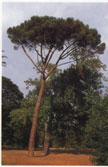 Pinenut, Italian Stone Pine, Pignolia Nut - Pinus Pinea
Pinenut, Italian Stone Pine, Pignolia Nut - Pinus Pinea
The kernels can be eaten raw, roasted or prepared into sweet meats, cakes, puddings, stuffing's, soups and of course the most popular usage is the Italian gourmet PESTO. It is the source of a high quality expensive oil that is made mostly in France.
Indian Almond - Terminalia catappa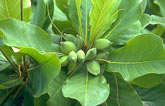
This large semi-deciduous tree from the Malaysia is widely planted in tropical areas as a street tree. The 50mm long fruit has a thin oily seed that is edible raw or roasted. The bark, roots and leaves contain tannin and the fruit also yields a dye.
Malabar Chestnuts - Pachira insignis
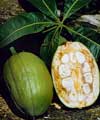 This medium sized fast growing evergreen tree is grown in many parts of the world. It is grown mainly for its delicious seeds however it also makes a suitable potted indoor plant or outdoor specimen. Overall, this versatile tree is a handsome landscape addition.
This medium sized fast growing evergreen tree is grown in many parts of the world. It is grown mainly for its delicious seeds however it also makes a suitable potted indoor plant or outdoor specimen. Overall, this versatile tree is a handsome landscape addition.
The seeds can be eaten either raw or roasted. When roasted or fried in oil they taste like chestnuts or cashews, raw they taste like peanuts and keep for months in a cool, dry place. They can also be ground and used as a flour substitute when baking bread. The young leaves and flowers are cooked and delicious eaten as a vegetable.
Production starts within a few years. The large, white, self-fertile flowers display spectacular clusters of 10cm cream-white stamens. The fruit is a woody green five-valved pod up to 30cm in length. The capsules that follow burst open when the seeds are ripe.
The plant grows well in mild inland parts and coastal areas. The plant will tolerate brief exposure to low temperatures but won't tolerate frost. A frost-free location with some protection from hot, drying winds is the best choice for the plant. It will take full sun to partial shade. Malabar chestnuts are not overly fussy about soil as long as it is well drained.
Our Plants of the Month;
Our new Perennial Vegetables and Spice Plants-
French Sorrel - Rumex scutantus
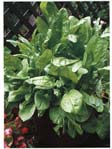 Sorrel is a slightly lemon flavoured green perennial herb used as a delightful tangy salad green. In peeling through your French recipe books you may also find French sorrel listed as Buckler sorrel. It is a refined plant that grows as a clump reaching 30-40cm with leaves 4-6cm across. It is a very hardy plant that will continue to flourish when the rest of your fresh garden greens are suffering either from heatstroke or the chills. Sorrel is best located in the full sun or with some afternoon shade and loves rich well-drained soil that is kept fairly moist. Fertilise in spring and again in summer if the leaves are looking pale. The plant may need protection from slugs and snails as they relish the tender leaves.
Sorrel is a slightly lemon flavoured green perennial herb used as a delightful tangy salad green. In peeling through your French recipe books you may also find French sorrel listed as Buckler sorrel. It is a refined plant that grows as a clump reaching 30-40cm with leaves 4-6cm across. It is a very hardy plant that will continue to flourish when the rest of your fresh garden greens are suffering either from heatstroke or the chills. Sorrel is best located in the full sun or with some afternoon shade and loves rich well-drained soil that is kept fairly moist. Fertilise in spring and again in summer if the leaves are looking pale. The plant may need protection from slugs and snails as they relish the tender leaves.
How to prepare: Sorrel leaves are used to add a citrusy tang and acidic note to a mixed green salad. You can accentuate their flavour by adding lemon juice to your dressing or garnish with tangelo or orange segments. Sorrel is one of many salad greens that contains small amounts of oxalic acid. This can be improved with the addition of honey or fruit juices if the acid is too strong for your liking.
From our Exotic Fruits Section -
Sea Grape - Coccoloba uvifera
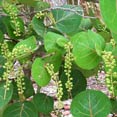 Apart from producing delicious fruit and plenty of it these trees have a spectacular appearance. They are very unusual having a plate-like waxy leaf that can reach up to 20cm in diameter. On a hot day the leaves make an ideal fan. They are very tough, require little maintenance and don't mind sandy soil and salt spray. They are mostly found growing along the seaside and enjoy the strong light reflected from the water.
Apart from producing delicious fruit and plenty of it these trees have a spectacular appearance. They are very unusual having a plate-like waxy leaf that can reach up to 20cm in diameter. On a hot day the leaves make an ideal fan. They are very tough, require little maintenance and don't mind sandy soil and salt spray. They are mostly found growing along the seaside and enjoy the strong light reflected from the water.
The fruit itself is grape like although a bit tougher than the ordinary grape and it has one large seed as opposed to several small ones. They remain green and hard for a long time but eventually one by one they change to their mature deep purple colour. They hang in bunches, each one with a single seed, and are about the size of regular grapes. When fully mature, they become soft and have a sweet-sour taste making them great for use in jams and jellies. It is possible to make an alcoholic beverage made from the grapes, similar to wine.
The resin of the bark is used in tanning and dying. The wood is used to make furniture and as fuel. The flowers are small, fragrant, and 5-pointed with flaring white petals.
Ylang Ylang - Cananga odorata
 This tall tree, from the custard apple family, is very popular throughout Asia for its fragrant flowers. Reaching 15-20 metres in is tropical home, it makes a stunning large specimen with its glossy foliage and elegant pale yellow heavily scented flowers, which are in abundance during March and April.
This tall tree, from the custard apple family, is very popular throughout Asia for its fragrant flowers. Reaching 15-20 metres in is tropical home, it makes a stunning large specimen with its glossy foliage and elegant pale yellow heavily scented flowers, which are in abundance during March and April.
The essential oil is distilled from flowers and used as a flavouring in sweets, icings, baked treats and soft drinks.
See the following website for details on the wide uses and properties of the Ylang Ylang. http://www.choicesforhealth.net/Aromatherapy/ylang_ylang_oil.htm
From our Bush Foods Section -
Native Australian Round Lime - Citrus australis
A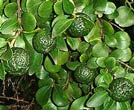 lso known as “Dooja” or Gympie lime or – Occurs naturally on the fringe of lowland sub-tropical rainforests of southeast Qld, from Brisbane northwards. This slender tree can reach up to 15m in height and 6-8m in diameter with multiple trunks, making it the most vigorous of the native citrus. The round knobbly fruit, usually reaching 3.5-4 cm in diameter have a distinctive and recognisably citrus flavour, with a similar globular texture to the more commonly known Finger Lime.
lso known as “Dooja” or Gympie lime or – Occurs naturally on the fringe of lowland sub-tropical rainforests of southeast Qld, from Brisbane northwards. This slender tree can reach up to 15m in height and 6-8m in diameter with multiple trunks, making it the most vigorous of the native citrus. The round knobbly fruit, usually reaching 3.5-4 cm in diameter have a distinctive and recognisably citrus flavour, with a similar globular texture to the more commonly known Finger Lime.
The round lime is suitable for including in cordials, sauces, marmalades and lime flavouring. The skin is very thick (up to 7mm) and has potential for culinary use, such as grating into spice pastes, or for candied peel and may also have potential for essential oil extraction.
The trees listed above and many more are available at Daleys Nursery. See our website at https://www.daleysfruit.com.au.htm and go straight to the shopping trolley to order these plants or call in and see Emma at the Nursery for more information.
For Even More Information ...........................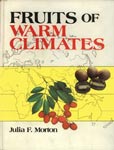
Fruits of Warm Climates by Julie .F. Morton available on Line
See http://newcrop.hort.purdue.edu/newcrop/morton
This book covers more 120 species, presenting a wealth of information including detailed plant descriptions, notes on varieties, pollination, climate, soil, culture, yield, harvesting, and pests and diseases.
HANG YOUR GARDENING GLOVES AND COME INSIDE INTO MY KITCHEN -
This month's recipe is brought to you from my courageously experimental kitchen from which the occasional creative experiment turns into a gourmet delight. This one came from a broad band of abundance of Bunyas, Quinces and Bananas all in season in my garden.
|
Quince and Banana Pie with Mango and Jackfruit sauce
|
|
|
Ingredients for base: Ingredients for filling: Ingredients for topping: Method: Ingredients for sauce: |
|
The Inaugural Queensland Organics Conference
The Organic Producers Association of Queensland (OPAQ) is presenting this conference in Cairns on 31 July –1 August 2003. On current trends the organic agriculture industry is estimated to grow by 40% by 2006 and this conference will be the first opportunity for the organic industry in Queensland to come together as a whole. The conference theme “Organically Speaking – Soil and Society” will set the stage form bringing together an awareness of the relationship between human society and the natural environment.
Welcomed Feedback
Thankyou to all of our customers that have offered us feedback. We appreciate your comments and suggestions. Our business continues to improve and grow due to the valued feedback of our customers.
Next Issue
This time I'll definitely cover the benefits of nitrogen fixing plants in your orchard
As well beneficial pest repellent plants for your fruit trees
Frogs attracting plants
and much more







